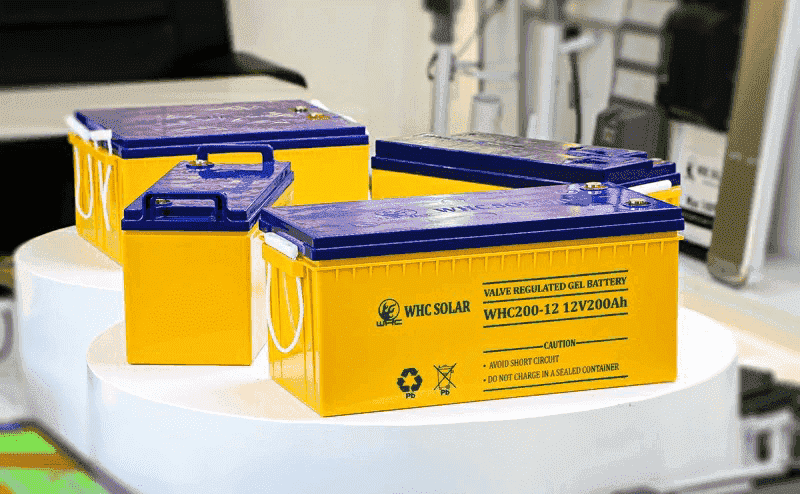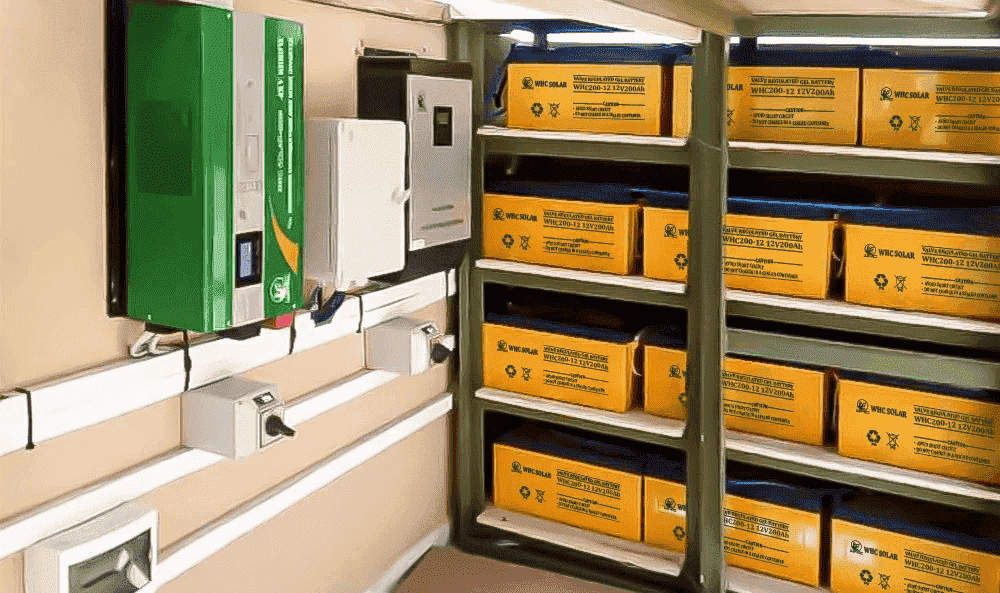When it comes to powering home appliances sustainably, solar gel batteries are great alternatives. There are lots of questions that come to mind like, “what is a gel battery? Would this new battery technology be sufficient for my solar system designs? How do I choose a gel battery manufacturer?”
Gel batteries are suitable for off-grid solar systems. They can function as a backup energy source for already installed solar panels or solar kits. In this article, we will give answers to some burdensome questions and explain everything you need to know about the solar gel battery, its pros and cons, and comparing it with the AGM battery technology.
What is a Gel Battery?

Gel batteries are batteries that use a gel-like electrolyte. The gel-like electrolyte is obtained by mixing sulphuric acid with silica to allow it to stiffen and become more viscous than liquid. Gel batteries are adequately designed to solve some problems you would encounter while using the popular wet lead-acid batteries. Although gel batteries share a lot of similarities with lead-acid batteries in terms of design and working principles, they differ in their components. While a lead acid battery uses a liquid electrolyte solution, a gel battery uses a more viscous electrolyte. The electrolyte consists of sulphuric acid mixed with silica as its hardener. Because silica gives the solution a gel-like feel, solar gel batteries do not emit as many fumes as traditional batteries.
The solar gel battery is also very light and stable. As a result of this, they are easy to install. They also have longer lifespans and can hold their charge longer than regular batteries. These features have also led to the widespread usage of gel batteries for solar panels. Their durability and other favorable properties have made them a go-to choice in various applications such as medical mobility devices, electronic devices, marine equipment, and solar-powered devices.
How Does a Gel Battery Work?
A gel battery sometimes called a gel cell battery, is a valve-regulated lead-acid (VLRA) battery. The battery components are gel-like electrolytes and sulphuric acid, which are combined with silica fumes. The presence of silica in the gel battery causes a chemical reaction to take place, resulting in the formation of the stationary gel-like substance from which the battery earns its name.
Gel batteries are made with flat or tubular positive plates. These batteries use the immobile gel mass in utilizing electrolytes and sulphuric acid in the same way as a typical lead-acid battery. Gel batteries have a one-way system of open valves that permit the gases within to recombine with water. This makes them require zero maintenance as there is no need to check for water level on the top.
These batteries are very versatile and produce very little gas or fumes. As a result, they can be safely installed in places with limited ventilation, such as residential homes.
Advantages of Solar Gel Batteries
Several benefits of gel batteries make them an increasingly popular option for solar energy systems. They include:
- Maintenance-free: Solar gel batteries are made up of a gel-like substance instead of liquid, so they require little to no maintenance to function well.
- Spill-proof with no fear of leakage: Wet cell batteries have a high possibility of leakage even though they have plastic casings. In the case of solar gel-type batteries, the reverse happens. Thanks to the gel-like substance and pressure-removing valve in these batteries, there is no risk of leakage.
- Flexible design and installation: Gel batteries are spill-proof, which makes it possible for them to be used in both horizontal and vertical positions. This feature is incredibly beneficial for a wide range of battery applications.
- Deep cycle applications: Gel batteries are the ideal choice for deep cycle applications because they have life cycles of 500 to 5000 cycles. This means they can be discharged more and recharged like a new one.
- Rugged and resistant build: These batteries have non-conductive plastics on their exterior, making them resistant to heavy vibrations, shocks, and other substantial impacts. This feature makes them suitable for four-wheelers.
- Minimal risk: With gel batteries, there is less risk of spillage. There is no risk of sulfuric acid burns and damage to equipment. As opposed to lead-acid batteries, where you may be faced with clean-up hazards in the event of spillage, you do not have to worry about spillage. In addition to this, there is less chance of corrosion, and gel batteries are commonly used with sensitive electronic equipment.
- Better heat tolerance: Other than being lighter than regular batteries, gel batteries have a high tolerance for heat. They can be adequately used in places with limited ventilation systems.
Disadvantages of Solar Gel Batteries
Although solar gel batteries have a host of benefits, they have certain disadvantages to them. The key disadvantage of these batteries is seen in the gel solar battery price. Solar gel batteries are typically more expensive than other battery types.
The slow charge rate of gel batteries is also another concern. Compared to the traditional variants, these batteries take quite a long time to attain full charge. Another thing is that the charger needs to be taken out immediately after the charging process is complete to prevent the risk of irreversible damage. Because these batteries have a gel electrolyte, overcharging them can cause voids with the electrolyte and, consequently, reduce the lifespan of the battery. It may even become necessary to use special regulators while charging these battery types.
Frequently storing gel batteries in hot areas can adversely affect the gel, causing it to get hard and shrink away from the plates. The batteries would then not last as long as they should.
What is Better: AGM or Gel Battery

The AGM versus Gel battery debate is one that is very common, with everyone wanting to know which battery is actually the better option for a range of applications. Since they have certain similarities, many people tend to think the AGM battery is a viable choice. Several qualities make gel batteries stand out against AGM batteries.
To answer the question of which is better, we would make comparisons below between both batteries to help you make an informed decision on the type of battery that is great for you.
What Does AGM Battery Mean?
The AGM battery, short for Absorbent Glass Mat, is a type of VLRA battery with sealed battery technology. In the battery, the electrolytes are confined in thin fiberglass mats with lead plates on both sides. The ultrathin glass mat, also called AGM separator, soaks up the electrolytes so that they do not freely flood the plates as in regular flooded batteries. AGM batteries perform optimally because the glass mat provides a large surface area for the reaction between the electrolyte and lead plates. The valve helps to regulate pressure within the battery, protecting its structural integrity. AGM batteries are very useful in many deep-cycle applications, such as marine, aviation, and off-grid power systems.
Pros of AGM Battery:
- They are lightweight and durable, with the ability to withstand freezing. Although they won’t generate power in colder temperatures, the plates won’t crack and remain undamaged.
- They have a longer lifespan than traditional batteries. When properly maintained, they can last longer than sealed lead-acid batteries.
- They have lower internal resistance, which allows for fast power generation, especially in car batteries which need quick power bursts for the engine to start.
- AGM batteries are shock and vibration-resistant. The electrolyte-saturated glass mats act as a damper, and with the plates tightly packed, the effect of sudden impacts is reduced to the barest minimum. This is advantageous in military airplanes.
- They are spill-proof and can be used in places with limited ventilation because they have minimal gas outputs. They are also maintenance-free batteries.
- They have a fast recharge rate and a higher depth of discharge of 80% making them ideal for deep cycle applications such as UPS systems, golf carts, RVs, and marine vehicles.
Cons of AGM Battery:
AGM batteries have some drawbacks, just like other battery types. The primary downside of these batteries is that they are relatively expensive. They cost more to manufacture than conventional batteries, making them more expensive.
These batteries are also prone to getting damaged from overcharging. Being sensitive to overcharging and high voltages, their lifespan -and performance- can be adversely affected. It would be best to use the specified chargers and regulators for the batteries for optimal longevity.
AGM VS Gel Battery
The AGM vs gel battery comparison is necessary because they have similarities that some people may find confusing. So what makes them different?
| Feature | Gel batteries | AGM batteries |
| Cost | They are more expensive because they cost more to manufacture | Less expensive |
| Charge | It can be damaged if overcharged, incorrectly charged, or used with a tapered charger. | Charges quickly and able to hold charge well |
| Internal resistance | They have higher internal resistance and do not work well with appliances needing high currents. Cannot be used as starter batteries. | Low internal acid resistance and can be used as starter batteries. |
| Internal structure | Gel batteries have thinner plates, and the electrolyte is suspended in the case of a gel battery. | Internally, the electrolyte is suspended by a fiberglass mat with thicker plates to prevent leakage. |
| Thermal runaway | Better heat tolerance and more suited for high temperatures, performing well in areas with poor ventilation. | They conduct heat poorly because the glass mat acts as an insulator and is better suited to colder temperatures. |
| Life expectancy | Can be discharged up to 90% and will have higher performance and lifespan if well taken care of. | Although AGM batteries can last for years, frequent discharging significantly shortens the life cycle. |
Conclusion
Gel batteries are a worthwhile investment when adequately taken care of. They have peak performance rates throughout their lifespan when used rightly. Although solar gel battery prices are higher than similarly sized wet-cell batteries, they have better performance in various setups. Coupled with other unique features, these batteries are safer and more reliable than the other alternatives.
Still, trying to decide which is the right battery option? WHC SOLAR offers gel battery solutions for all unique applications. A renowned solar products manufacturer, WHC SOLAR has all-in-one solar gel batteries for sale. Visit us online or call us today to make inquiries about the best gel batteries for solar applications.

